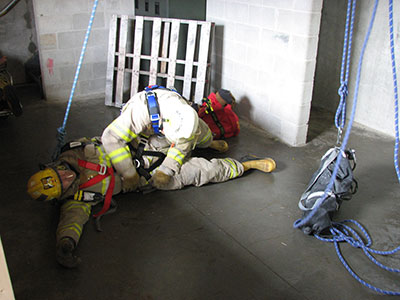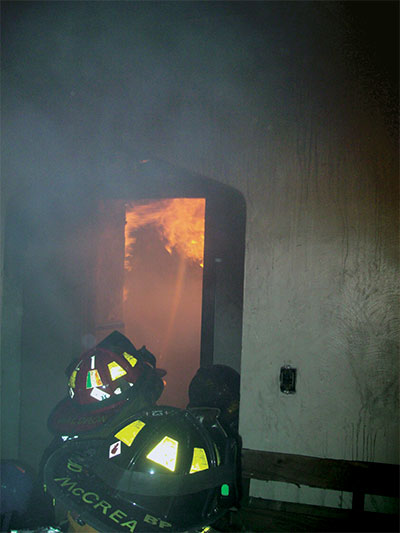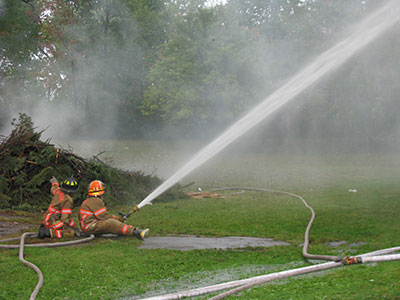
Back to Basics: April 2014
Mark Van
Features Structural TrainingWhenever firefighters enter a structure to fight fire, there is a chance that a firefighter – or two – will fall through the floor.
Whenever firefighters enter a structure to fight fire, there is a chance that a firefighter – or two – will fall through the floor. Several factors contribute to the possibility of firefighters falling through the floor including an increase in fuel loads within buildings, an increase in the use of lightweight construction materials and methods, and failure by firefighters to check the floor in front of them.
There have been numerous incidents of firefighters falling through floors and into burning basements. Some of these incidents have had positive results with the firefighters being rescued, while other times firefighters have succumbed to their injuries.
One such fatal incident took place on July 25, 1987, at a three-alarm fire in Columbus, Ohio. Firefighter John Nance was killed in the line of duty when he fell through the floor into a burning basement; many rescue attempts had been made but failed.
The Nance Drill was developed and named after that firefighter as a way for crews to practise rescuing firefighters from a sub-grade or sub-level situation. This drill is now incorporated into RIT training as a means to a quick and effective resolution for this type of situation.
Closer to home, at a six-alarm fire in Toronto on Jan. 3, 2011, a captain and a firefighter slipped off of the roof of the famous HMV store on Yonge Street and fell into the burning heritage building next door. The two firefighters were conscious, were able to declare a mayday on the radio and were rescued by other working fire crews.
Downed firefighters may be in one of three conditions:
- Conscious, self-assist/self-rescue: The firefighter does not sustain major injuries and is able to help himself with the assistance of others above him. No RIT or other firefighters need to descend into the lower level to assist with removal.
- Conscious, needs assistance from RIT or other firefighters: The firefighter has sustained some major injury or is otherwise physically incapacitated. He requires the assistance of the RIT or other firefighters who must descend into the lower level for rescue operations. Communication with the downed firefighter is secured and maintained throughout the operation. The downed firefighter can assist with the rescue operation in a limited capacity.
- Unconscious, needs assistance from RIT or other firefighters: The firefighter has sustained major injury or is physically incapacitated. He needs the assistance of the RIT or other firefighters. There is no communication with the downed firefighter as he is unconscious. There is also no assistance from the downed firefighter; the rescue operation must be completely conducted by the RIT and the other firefighters from above.
When there is no access to the sub-level area except from above, use a ladder, a charged hoseline or a life-safety rope to rescue the downed firefighter. Still, RIT members should first consider accessing the downed firefighter from the lower level. Using a rotary saw to cut a hole in the side of a wall to gain access to the firefighter may be the quickest and most effective tactic. This access point will provide a direct path to the downed firefighter, allowing any equipment or personnel required for the operation to easily switch out. This also enables the direct removal by means of a Stokes basket or similar device.
Don’t waste time debating the best access point to use. Quickly decide how and from where to make access.
When the downed firefighter is accessible only from above, the rescue operation may be a little more intricate and time consuming, depending on the size of the opening. The RIT may need to make the opening bigger to provide a larger work area for the operation. When widening the hole, pay careful attention to the structural support and the condition of the immediate area. The cutting operation may cause the area to collapse further since it has already been weakened by fire.
The area beneath the opening may also need to be cleared out to prevent any obstructions, such as ceiling debris or materials, from hindering the removal of the downed firefighter up through the opening.
When working around the opening of the hole, stabilize the immediate area by using existing doors inside the structure as stabilization plates. The door to a bedroom or bathroom can be removed and laid flat at the opening of the hole to provide a stable work platform. Doors are an excellent resource as they are small enough to move around inside a structure and are immediately available. Also, consider the weight distribution of the firefighters working the rescue. Poor distribution presents a greater chance of secondary collapse or of other firefighters falling through the same area. If another firefighter falls through the hole, the incident commander must decide whether to continue with the rescue or to suspend it.
The successful outcome of the rescue operation also depends on providing a defendable space for the downed firefighter. Use a charged hoseline to prohibit the spread of the fire. Protecting the downed firefighter from further harm is critical to his survival. In the Toronto fire, master streams were used to keep the fire away from the captain and the other firefighter while the rescue operation ensued.
If the downed firefighter is conscious, he or she can assist by operating the hoseline to keep the fire at bay. The hoseline can also be used to rescue the downed firefighter; we will explore this further in part 2 in July.
Mark van der Feyst is a 15-year veteran of the fire service. He works for the City of Woodstock Fire Department in Ontario. Mark instructs in Canada, the United States and India and is a local-level suppression instructor for the Pennsylvania State Fire Academy and for the Justice Institute of BC. E-mail Mark at Mark@FireStarTraining.com
Print this page


